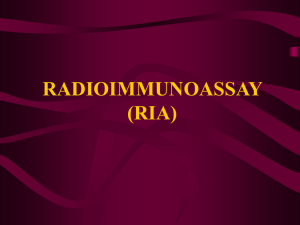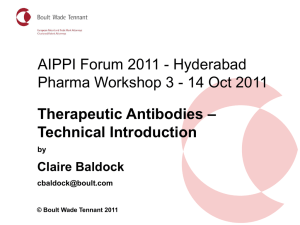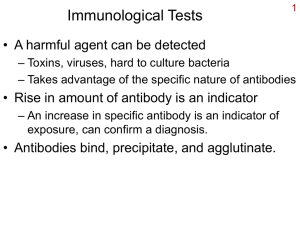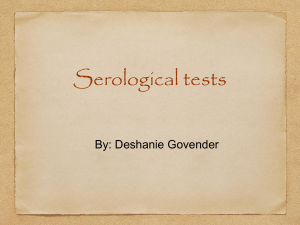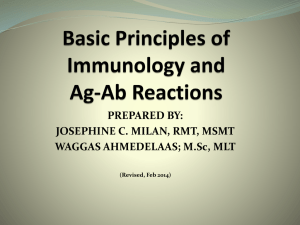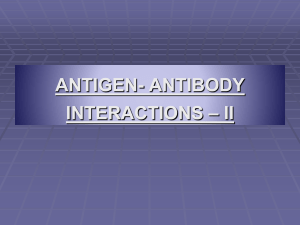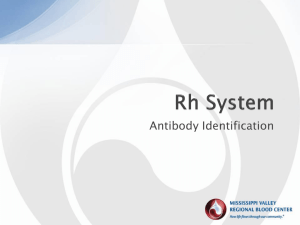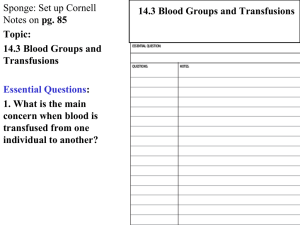antigen-antibody reaction
advertisement
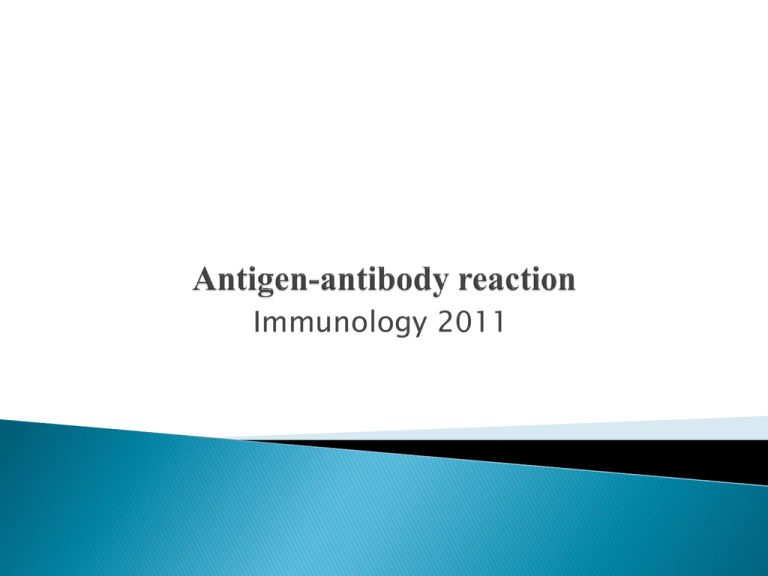
Immunology 2011 The interaction between antigen and antibody ag - ab reaction Antigen-antibody reaction is characterized by following salient features. 1. 2. 3. 4. 5. 6. 7. Immune Complex Specificity of Ag-Ab Reaction Binding Sties of Antigen and Antibody Binding Forces of Antigen and Antibody Avidity Bonus Effect Cross Reaction When antigen and antibody are brought together, the antibody binds with the antigen to form a complex molecule called immune complex or antigenantibody complex Ag + Ab Ag-Ab complex Specificity refers to the discriminate ability of particular antibody to combine with only one type of antigen. An antibody will combine with the antigen which is the cause for its production. Epitope (antigenic determinant)- The part of the antigen which combines with the antibody. Paratope (antigen binding site) - The Part of the antibody which combines with the antigen. Binding between antigen and antibody is due to three factors namely, 1. Closeness between antigen and antibody 2. Intermolecular forces 3. Affinity of antibody Avidity refers to the capacity of an antiserum containing various antibodies to combine with the whole antigen that stimulated the production of antibodies. Avidity is used to denote the overall capacity of antibodies to combine with multivalent antigen the antibody not only binds with the antigen but also the antigens are bridged by a single antibody. In some cases two antigens may be bridged by a single antibody. Such a binding is weak. But when two antigens are bridge by two antibodies, the binding will be strong. This phenomenon of giving extra- strength to the antigen-antibody complex by the binding of two antibodies to two antigen molecules is called bonus effect. An antiserum raised against a given antigen may sometimes react with another closely related antigen - cross reaction the antigen which produces the cross reaction is called cross reactive antigen. The cross reaction is due to the presence of one or more identical antigenic determinants on the related antigen. 1. 2. 3. 4. 5. 6. 7. Precipitation Agglutination Cytolysis Complement fixation Flocculation Opsonization Immunoflurorescence reaction between a soluble antigen and its antibody resulting in the formation of insoluble precipitate. The antibody - precipitin. due to the formation of Antigen-antibody complex. The antigen is multivalent and the antibody is bivalent. As each antibody is a bivalent molecule, it can bridge two multivalent antigen molecule. This bridging leads to the formation of a lattice which forms the precipitate. When antigen and antibody are in optimal concentration the precipitation is complete and a large lattice is formed. reaction where the antibody of serum causes the cellular antigens to adhere to one another to form clumps. Antibodies - agglutinins antigens – agglutinogens When red blood cells are agglutinated, the reaction haemagglutination. bacterial agglutinations is the dissolution of a cell. RBC is lysed - haemolysis. bacterial cell - bacteriolysis. Mechanism of Cytolysis: the antigen-antibody complex activates the complement. complement binds to the surface antigen of microbe or cell. The compliment fixed on the surface of the cell causes the disruption of the lipid bilayer of the membrane of the microbe. As a result, a hole is made on the microbe. Through this hole the content of the cell are released and the cell is lysed. The binding of complement to antigen – antibody complex is called complement fixation. When complement is added to a serum containing an antigen and its antibody, the complement is activated and immediately it binds to the Antigen-antibody complex and the complement is said to be fixed. antigen- antibody reaction brought about by exotoxin and antitoxin. reaction produces flocculates which do not sediment but remain dispersed in the medium. Flocculation is somewhat like precipitation, but the precipitates will not sediment. Process by which a particular antigen becomes more susceptible to phagocytosis by combination with an opsonin. Opsonin is an antibody when combines with a particulate antigen, increases the susceptibility of the antigen to phagocytosis In Opsonization - the antibody combines with the surface antigen of bacteria. This antigen-antibody complex activates complement system. The activated complement is attached to the antigenantibody complex to form an antigen-antibody complement complex. the antigen-antibody-complement is adhered to the phagocytic cells. The microbe ( antigen) fixed on the phagocytic cell is killed by phagocytosis or lysis. When antibodies are mixed with fluorescent dyes such as fluorescein or rhodamine, they emit radiation. Phenomenon of emitting radiation by antibodies labeled with fluorescent dye- immunofluorescence. The immunofluorescence can be observed by a fluorescent microscope. Application of Immunofluorescence It is used to locate and identify antigen in tissues. Certain pathogenic bacteria can be identified. Antibodies directed to cell or tissue antigen can be detected. Direct method the antibody labeled with fluorescent dye is applied directly on the tissue section. The labeled antibody binds with specific antigen. This can be observed under the fluorescent microscopic. rabies can be diagnosed.
